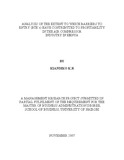| dc.description.abstract | Industry attractiveness is the (relative) future profit potential of a market. It is mainly
measured by industry growth and average industry profitability. However other attractive
industry characteristics like stability of demand, potential for entry and exit by major
firms etc may be used. In general, industry attractiveness can be determined by analysing
the competitive market forces. Porter (1980) provided a framework that models industry
as being influenced by five forces. These forces are threat of new entrants, threat of
substitute products, bargaining power of buyers, bargaining power of suppliers and
rivalry among existing competitors. The combined effect of these forces determines the
industry competition and profitability. However, it is expected that where incumbent
firms are doing well and perceived profits exceed the cost of entry or of surmounting
mobility barriers, new firms will enter the industry.
The objective of this study was to analyse the extent to which entry barriers have
contributed to profitability in the air compressor industry in Kenya. Secondly, it sought to
establish why the industry in spite of being profitable attracted only five players over a period of 71 years.
The research design was a cross sectional survey of the five incumbent firms in the
industry based on Porter’s five force industry model. Senior managers of these firms were
interviewed using a standard questionnaire.
The research findings confirmed that Porter’s five industry forces were at play in the air
compressor industry in Kenya and that each force had a varying degree of influence on
company profitability. However the threat of new entry was found to be the strongest
force and the one that governed the rules of competition in the industry. It was the most
critical for strategy formulation. Further, it was concluded that the competitive structure
of the industry was unique and clearly attractive from a profit-making stand point. It was
also found that competitive rivalry among the incumbents was moderate, high entry
barriers existed, competition from substitutes was negligible, and buyers had a low
bargaining leverage. On the other hand suppliers had considerable leverage. | en |

